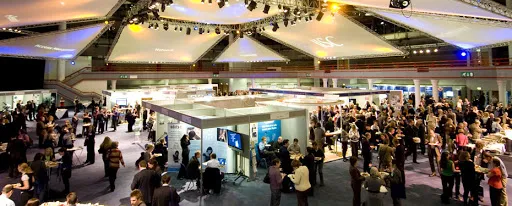
Originally posted on the KantanMT blog on July 11, 2021
If you were to ask the average person to put a date on the beginning of the hugely important business events that are industry trade exhibitions, many would struggle to get it right. Some might point to the World Trade Fairs that flourished in the late 19th and early 20th centuries. Driven primarily by the industrial revolution, these were hosted by countries as a way of promoting to the world the prowess of their industries.
However, the first reported business industry fair, as we would know it today, was held in Persia as early as the 15th century. Its function was to gather the manufacturers of products into one bazaar-like setting to allow them to promote and sell their products on a business-to-business (B2B) level. At the end of the 18th century, the idea of hosting B2B gatherings where products were displayed but not sold took hold across Europe. Businesses soon saw the advantages of inviting their customers and prospective customers to gather in a common area to view and discuss their business needs. As such, an industry was born and today the successors of those early efforts have become a massively profitable entity. So much so, in 2019, the global B2B trade show market was valued at US$34.4 billion, and by 2023, this figure is expected to surpass US$40 billion.
(Source: https://www.exhibitionworld.co.uk/)
Today, trade shows are considered a traditional marketing strategy used by companies to showcase their latest products and network on a B2B level. The objective is to increase brand awareness and drive sales and to do so by gathering with similar industries in a common area so gaining great synergy from the volume of traffic attracted. These congregations facilitate the promotion of customer involvement, on-hands training on products, the launch of new products and an opportunity to probe customer sentiments.
However, the industry was dealt a huge blow when in 2020 the Covid epidemic swept across the globe forcing almost all exhibitions to close their doors and leave the huge exhibitions halls empty. A behemoth of international industry was brought to a shuddering halt. The effects of the crash spread everywhere, and beyond the exhibiting companies themselves. For every exhibition cancelled an army of supporters fell with it: hoteliers, taxi drivers, exhibition staff, catering staff, public transport, airlines, printing companies and on and on. Cities across the world such as Dusseldorf, Barcelona, Lisbon, London, and many more felt the cost of an industry forced to become dormant.
The exhibitions rushed to try and maintain some sort of momentum: to remain inert was not an option. Some exhibition organisers, such as the Websummit.com, overcame the obstacle by developing their own exhibition software. The Web Summit was able to cater for its 100,000 attendees online using this conference platform. In March 2021, Websummit.com made its conference software available for sale to other companies. Its first customer was the prestigious United Nations Development Program. Paddy Cosgrave, joint founder of the Web Summit conference, said that in the coming years his company “… hoped to help power many of the world’s leading events, as well as the events of many of the world’s leading organisations.”
It’s probable that the Web Summit team have stolen a march on its competitors and have moved its product into what has become a very lucrative market space. In 2019, the market for virtual tradeshow conference software was valued at US$77.98 billion, and this is expected to grow at a rate of 23.2% from 2020 to 2027. (Source: https://www.grandviewresearch.com)
One of the advantages of using virtual trade show technology is the amount of data it can capture. From the moment a client registers online the flow of intelligence begins. That data is then captured in a format that can be sliced and diced to lend itself to all kinds of business intelligence analysis. In the era of Big Data, this is a huge asset for any forward-thinking company. It is not always easy in a real-life conference setting to gather that level of intelligence. Yet, while trade fairs have been facing stiff competition from these digital marketing channels, they still are considered by many as one of the most profitable B2B media strategies available. Indicative of the resurgence of the real-time trade fairs is the announcement last week in Germany that the larger trade fairs there will resume. Germany hosts a vast number of international trade fairs such as the gigantic Medica fair.
AUMA, the Association of the German Trade Fair Industry points out that “small and medium-sized companies, in particular, are in urgent need of impulses from trade fairs – through the presentation of innovations, through personal confidence-building communication and the opportunity to win new customers.”
The figure for Germany alone gives an idea of the importance of this market: exhibitors and visitors spend a total of around €14,5 billion a year for their activities at trade fairs in Germany. The overall effect on economic production amounts to €28 billion. German exhibition organisers post sales of around €4 billion a year. Of the 10 highest-grossing trade fair companies in the world, five are headquartered in Germany. (Source: https://www.auma.de/)
With the B2B trade conventions proving to be the optimum place to set up multiple client meetings, at a time when international travel, hotel and entertainment costs can be justified by the ROI on the number of meetings that can be held in a brief time span, it is unlikely the bigger conventions will disappear. Some companies may indeed choose to reduce attendances and sponsorship at conventions considered less important to them. Therefore, these smaller conventions may well become the main customers for the virtual tradeshow software companies. Using that tool, plus a limited floor space exhibition in a convention center, they may be able to continue to be profitable and maintain their customer base.
However, the bigger conventions such as Medica, the Web Summit, Mobile World, CeBIT etc. are not about to disappear. As the market numbers for Germany alone show, no government will be anxious to lose such a lucrative cash cow. Therefore, expect these conventions to become the beneficiaries of increased grants and incentives. I also believe that physical conferences will also look to offer a virtual service for those unwilling or unable to travel. In addition, with the advent of innovative technologies around such things as virtual reality, and augmented reality, virtual viewing will become a more enhanced experience. But the greatest disadvantage of the virtual reality option will be a participant’s inability to collect that obligatory bag of free tee-shirts, pens and key rings that later lies untouched in the corner of their office.
Aidan Collins is Marketing Manger at KantanAI

